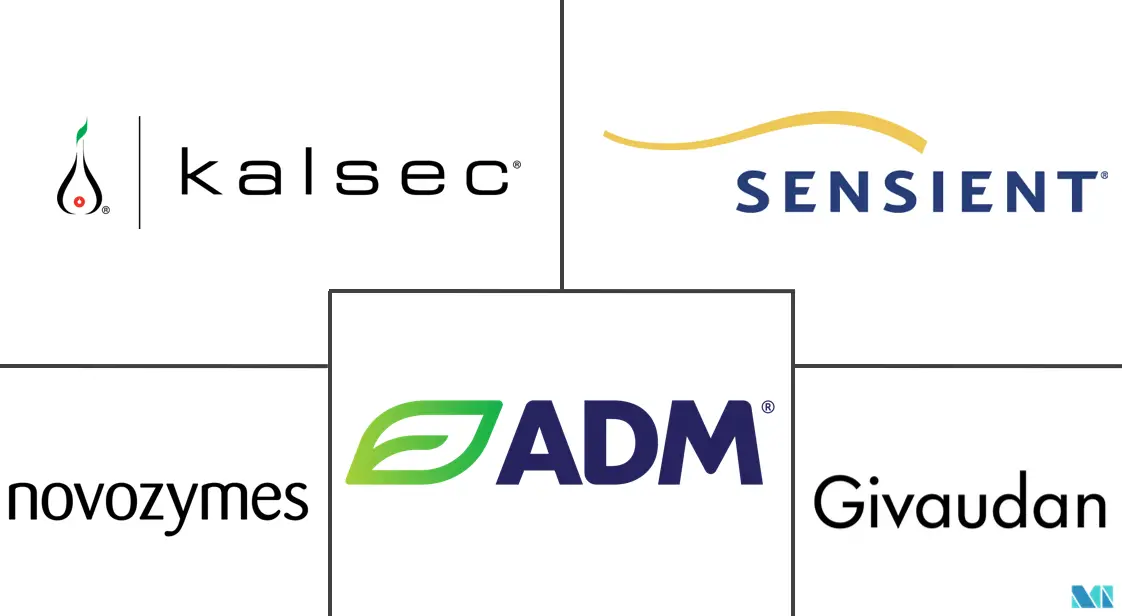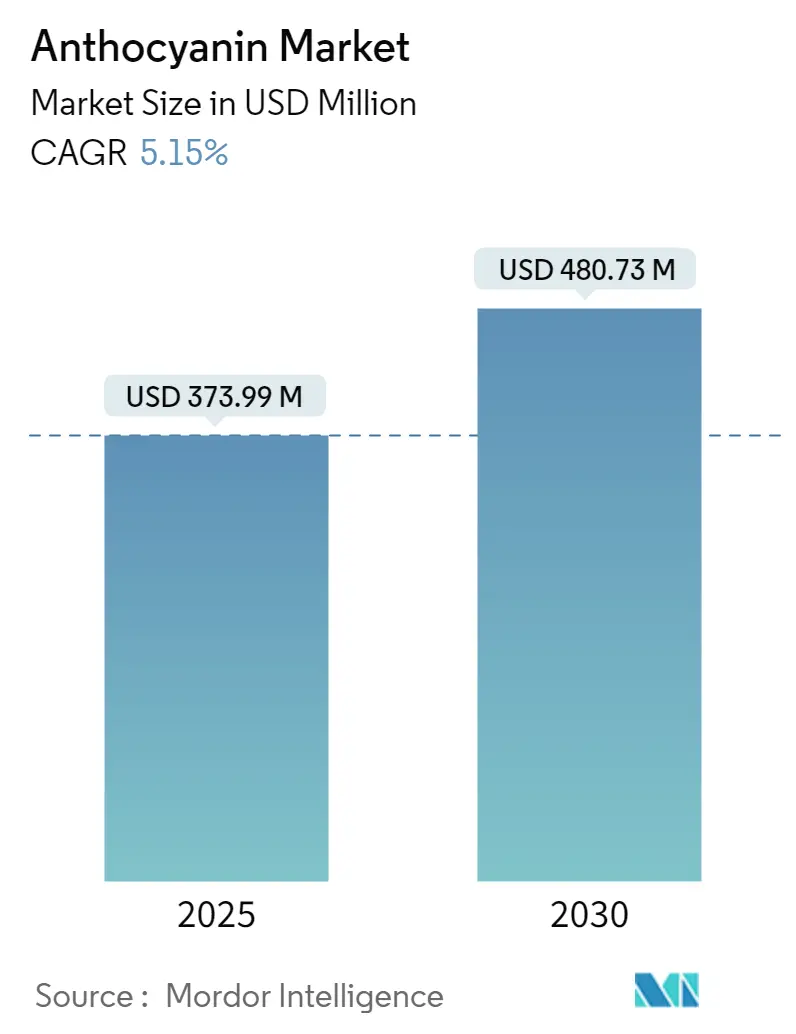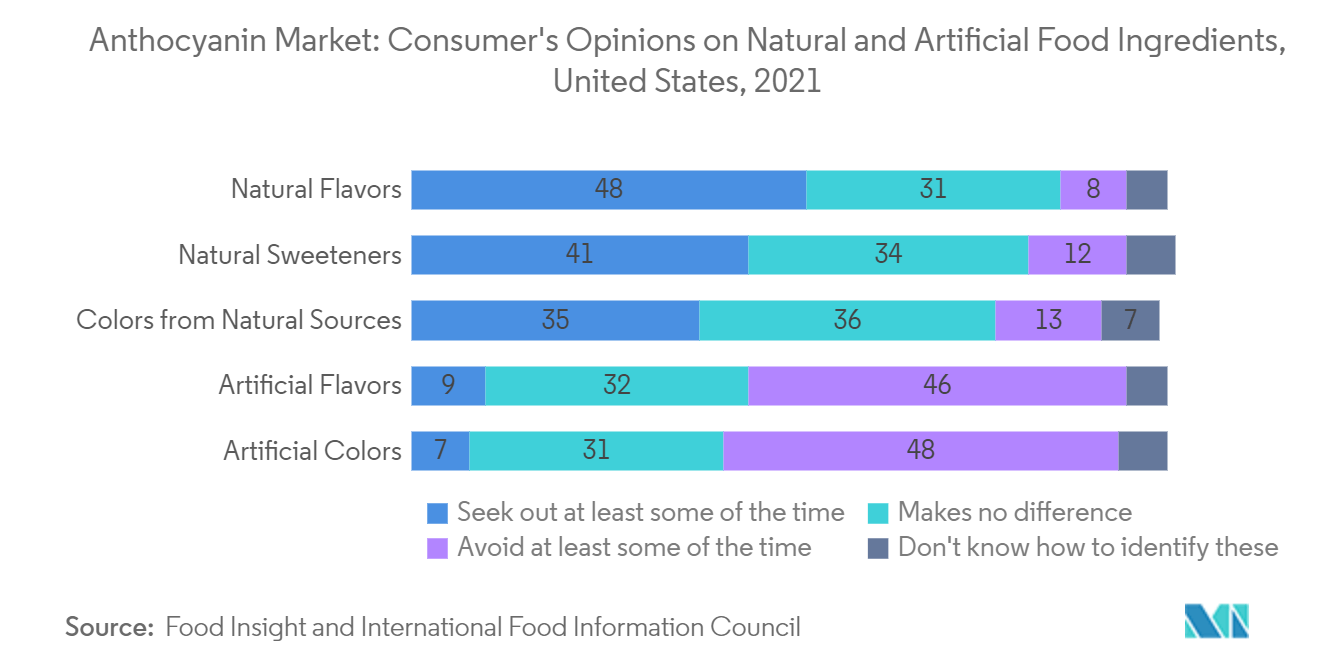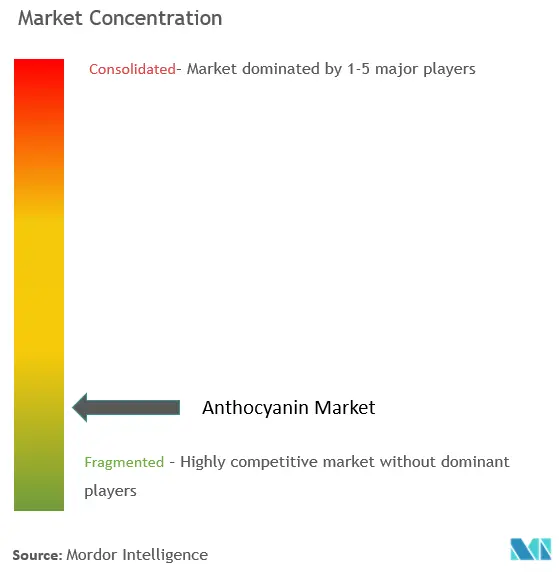Anthocyanin Market Analysis
The Anthocyanin Market size is estimated at USD 373.99 million in 2025, and is expected to reach USD 480.73 million by 2030, at a CAGR of 5.15% during the forecast period (2025-2030).
Anthocyanin is found in many foods, including blueberries, blackberries, raspberries, strawberries, cherries, purple grapes, beets, red cabbage, and red beans. Due to its functional properties, such as anti-allergic, anti-diabetic, anti-microbial, anti-inflammatory, and antioxidant, the market is driven by its increasing demand in the food and beverage industries. The other health benefits include reducing the risk of heart disease and respiratory disorders, which fueled the market sales.
The natural anthocyanins food colorants are responsible for colors, such as red, purple, and blue, which are found in fruits and vegetables. Berries, currants, grapes, and tropical fruits have high anthocyanin content. Also, anthocyanins are a type of flavonoid, a class of compounds with antioxidant effects. In addition to acting as antioxidants and fighting free radicals, anthocyanins may offer anti-inflammatory, anti-viral, and anti-cancer benefits. The extracted anthocyanin pigment from purple carrots is increasingly being used as an alternative natural red colorant for preparing hard candy and sweet jelly. Moreover, red carrot pigment is being used as a natural antioxidant in sunflower oil to delay rancidity of sunflower oil. Therefore, these increased application areas of anthocyanin are expected to drive the segment, hence, the players have been offering products to suit the dynamic demands of the clients, for example, NiroWell and Healthy Food Ingredients (HFI) offer their line of extracted Suntava Purple Corn ingredients powder. This extract powder has gained traction within the baking industry, as the ingredient is suitable for use as a natural color option for many clean-label applications, including snack foods and beverages.
The food and beverage industries account for the largest share of the market owing to the natural colorant with many health benefits, and the personal care sector is witnessing an increasing market growth trend. However, they are a promising alternative to synthetic food dyes as anthocyanins do not lead to side effects and toxicity if overconsumed and create no health hazards. The synthetic food dyes sector still accounts for a good share of the market owing to the lower cost and high stability compared to natural colors such as anthocyanins, chlorophyll, carotenoids, and turmeric, thus being the major factor restraining the market.
Anthocyanin Market Trends
Increasing Consumer Awareness Regarding Natural Products
- Anthocyanin is extracted from natural sources like fruits and vegetables and is an alternative to the synthetic colorants used in the food and beverage sector. Also, stringent regulations regarding the usage of synthetic red colors have fostered the demand for safe colorants, which is driving the market study.
- Countries, including Japan, Australia, Switzerland, and Norway, have banned the utilization of synthetic colorants Red 40 and 20 owing to their link with hyperactivity in children. Anthocyanin is replacing these additives owing to its safe nature. Also, Chile, European Union, Israel, Iran, Saudi Arabia, and South Korea defines all colors derived from anthocyanin as natural, which is a major driving factor owing to rising consumer awareness for safe and natural additives.
- Furthermore, with the surge in the consumer market to restrict extensive usage of artificial colorants in food products, the demand for natural food colorants, including anthocyanin, is expected to grow in the forecast period. In a survey performed in the United States by the International Food Information Council (IFC) in 2021, almost 48% of respondents said they look for natural flavors at least occasionally when choosing foods. As a result, companies are actively engaged in product launches that incorporate anthocyanins, thereby driving the market's growth.
- Moreover, prominent companies have been pursuing acquisitions of other enterprises operating in the market to expand their presence in both existing and new markets. For instance, Givaudan recently announced its agreement to acquire DDW, The Color House, a natural color company based in the United States. DDW offers anthocyanin products such as Amaize (red), aligning with Givaudan's strategic goals.
Asia-Pacific is Projected to Register the Fastest Growth
- Asia-Pacific has witnessed significant growth in the market owing to the shifting consumer preferences towards healthy ingredients in food, beverages, and personal care products, increasing disposable income of the middle class, and advancing investments supported by the expansions of domestic companies.
- A survey carried out in India by The National Family Health Survey (NFHS) between 2019 and 2021 revealed that 4% of respondents reported having diabetes. Hence, the rise in such medical conditions is also expected to drive the demand for anthocyanin in the market over the forecast period.
- China has seen considerable market growth due to evolving consumer tastes toward healthier ingredients in the cosmetics & personal care domain. For instance, according to the National Bureau of Statistics (NBS) of China, China's wholesale and retail businesses sold cosmetics at retail for roughly CNY 393.6 billion (USD 61.28 billion) in 2022. The application of anthocyanin has experienced significant growth, driven by the increasing demand for clean-label ingredients.
- To meet this rising demand, numerous ingredient companies are expanding their production capabilities and venturing into the Asia-Pacific region. Also, social media platforms are expected to be used on a large scale to increase customer base and market share, make people aware of the benefits of anthocyanin, and increase its demand in all sectors.
Anthocyanin Industry Overview
The anthocyanin market is highly competitive and fragmented, owing to the presence of many regional and domestic players. The leading players in the market include Novozymes A/S (Chr. Hansen), Kalsec Inc., Sensient Technologies Corporation, Archer Daniels Midland Company, and Givaudan (DDW The Color House).
Emphasis is given to the companies' mergers, expansion, acquisitions, and partnerships as strategic approaches adopted by the leading companies to boost their brand presence among consumers. Due to the experience and expertise of these leading companies in the global anthocyanin market segment, these leading players have been focussing on developing new products.
Further, economies of scale and high brand loyalty among end-users give these companies an upper edge. Further expansion of product portfolio within all categories may enhance the companies' positions in the market.
Anthocyanin Market Leaders
-
Kalsec Inc
-
Sensient Technologies Corporation
-
Givaudan
-
The Archer-Daniels-Midland Company
-
Novozymes A/S (Chr. Hansen)
- *Disclaimer: Major Players sorted in no particular order
Anthocyanin Market News
- September 2022: Givaudan Active Beauty introduced New Purple 2364, a vegan pigment specifically designed for use in makeup formulations. This sustainable pigment is derived through green fractionation from Raphanus sativus L., adding to Givaudan's portfolio of sustainable alternatives to synthetic pigments. The company initially launched this portfolio in 2020 with the introduction of New Red 1805.
- October 2021: GNT Group, B.V., manufacturer of Exberry Coloring Foods, announced an initial investment of USD 30 million to expand its operations in North America. The 49-acre facility in Gaston County, North Carolina, was intended to serve customers in the United States, Canada, and Mexico, expanding GNT's regional foothold in the worldwide natural color market.
- April 2021: Chr. Hansen Natural Colors, a renowned provider of natural colors with the widest portfolio in the industry, announced plans to continue its strong growth acceleration with the integration of SECNA Natural Ingredients Group S.L. into its portfolio in Copenhagen, Denmark.
Anthocyanin Industry Segmentation
Fruits, vegetables, nuts, seeds, and legumes are not only rich in vitamins and minerals but also contain a range of plant compounds that benefit your health. Anthocyanin is one such example. This antioxidant of the flavonoid family is purported to reduce inflammation and protect you from conditions like cancer, Alzheimer's disease, heart disease, and type 2 diabetes. Hence, anthocyanins that are derived from edible plants find their applications across various industries.
The anthocyanin market is segmented by type, application, and geography. Based on type, the market is segmented into cyanidin, malvidin, delphinidin, peonidin, and other types. Based on the application, the market is segmented into food and beverage, pharmaceutical, personal care products, and animal feed. Food and beverage are further sub-segmented into bakery & confectionery, dairy-based products, beverages, and other applications. The study also covers the global level analysis of the major regions such as North America, Asia-Pacific, Europe, South America, and the Middle East and Africa.
For each segment, the market sizing and forecasts have been done based on value (in USD million).
| Type | Cyanidin | ||
| Malvidin | |||
| Delphinidin | |||
| Peonidin | |||
| Other Types | |||
| Application | Food & Beverage | Bakery & Confectionery | |
| Dairy-based products | |||
| Beverages | |||
| Other Applications | |||
| Pharmaceutical | |||
| Personal Care | |||
| Animal Feed | |||
| Geography | North America | United States | |
| Canada | |||
| Mexico | |||
| Rest of North America | |||
| Europe | Spain | ||
| United Kingdom | |||
| Germany | |||
| France | |||
| Italy | |||
| Russia | |||
| Rest of Europe | |||
| Asia-Pacific | China | ||
| Japan | |||
| India | |||
| Australia | |||
| Rest of Asia-Pacific | |||
| South America | Brazil | ||
| Argentina | |||
| Rest of South America | |||
| Middle-East and Africa | South Africa | ||
| Saudi Arabia | |||
| Rest of Middle-East and Africa | |||
Anthocyanin Market Research FAQs
How big is the Anthocyanin Market?
The Anthocyanin Market size is expected to reach USD 373.99 million in 2025 and grow at a CAGR of 5.15% to reach USD 480.73 million by 2030.
What is the current Anthocyanin Market size?
In 2025, the Anthocyanin Market size is expected to reach USD 373.99 million.
Who are the key players in Anthocyanin Market?
Kalsec Inc, Sensient Technologies Corporation, Givaudan, The Archer-Daniels-Midland Company and Novozymes A/S (Chr. Hansen) are the major companies operating in the Anthocyanin Market.
Which is the fastest growing region in Anthocyanin Market?
Asia-Pacific is estimated to grow at the highest CAGR over the forecast period (2025-2030).
Which region has the biggest share in Anthocyanin Market?
In 2025, the North America accounts for the largest market share in Anthocyanin Market.
What years does this Anthocyanin Market cover, and what was the market size in 2024?
In 2024, the Anthocyanin Market size was estimated at USD 354.73 million. The report covers the Anthocyanin Market historical market size for years: 2019, 2020, 2021, 2022, 2023 and 2024. The report also forecasts the Anthocyanin Market size for years: 2025, 2026, 2027, 2028, 2029 and 2030.
Our Best Selling Reports
Anthocyanin Industry Report
Statistics for the 2025 Anthocyanin market share, size and revenue growth rate, created by Mordor Intelligence™ Industry Reports. Anthocyanin analysis includes a market forecast outlook for 2025 to 2030 and historical overview. Get a sample of this industry analysis as a free report PDF download.







